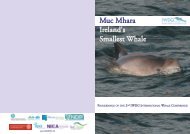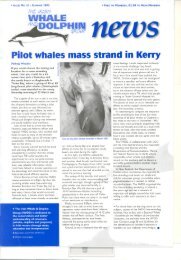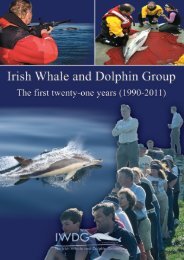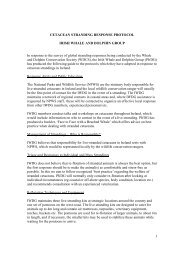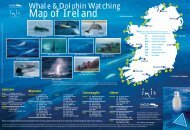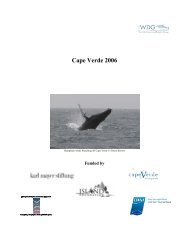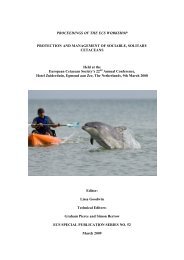downloaded here - Irish Whale and Dolphin Group
downloaded here - Irish Whale and Dolphin Group
downloaded here - Irish Whale and Dolphin Group
You also want an ePaper? Increase the reach of your titles
YUMPU automatically turns print PDFs into web optimized ePapers that Google loves.
the watch site, water depth off the headl<strong>and</strong> drops rapidly to<br />
30-40m. Slea Head is the most frequently watched site in<br />
Irel<strong>and</strong>, with 293 watches carried out since 1999. A total of<br />
564 sightings have been made of seven species. The<br />
proportion of watches with sightings is very consistent <strong>and</strong><br />
remarkably high, especially since 2004 when the number of<br />
watches per annum increased dramatically. Sightings were<br />
recorded on over 80% of watches carried out in sea-state 2 or<br />
less. Harbour porpoise (42%) was the most frequently<br />
observed species, followed by minke whale (34%), shortbeaked<br />
common dolphin (13%), bottlenose dolphin (4%),<br />
Risso’s dolphin (1%) <strong>and</strong> fin whale (two sightings). Harbour<br />
porpoise have been recorded throughout the year, with minke<br />
whales recorded from March to December, short-beaked<br />
common dolphin from February to October, Risso’s dolphins<br />
during the summer <strong>and</strong> bottlenose dolphins sporadically.<br />
T<strong>here</strong> were 106 watches in sea-state ≥3 which were removed<br />
from the analysis. The proportion of watches carried out in<br />
sea-state ≤2 with sightings of harbour porpoise was also high,<br />
though this has declined over the last two years. The<br />
proportion of watches with minke whales increased through<br />
2004 to a peak in 2007 before a decline since 2008, while the<br />
proportion of watches with short-beaked common dolphin<br />
sightings also peaked in 2007 <strong>and</strong> 2008 <strong>and</strong> declined in 2009.<br />
T<strong>here</strong> were no significant differences in sighting rates of<br />
harbour porpoises between 2004 <strong>and</strong> 2009 nor of shortbeaked<br />
common dolphins between 2006 <strong>and</strong> 2009. T<strong>here</strong><br />
was a significant variation in sighting rates of minke whales<br />
between 2004 <strong>and</strong> 2009, with an elevated sighting rate in<br />
2007.<br />
Loop Head, Co Clare<br />
Loop Head extends to the west with the approaches to the<br />
River Shannon to the south <strong>and</strong> the Atlantic seaboard of Co<br />
Clare to the north. The Shannon plume w<strong>here</strong> the River<br />
Shannon mixes with the Atlantic can be clearly seen extending<br />
to the west. Water depth drops rapidly to 60-70m. The first<br />
watch from Loop Head was carried out in January 1994 but<br />
coverage has been good since 2006. Since then, 89 watches<br />
have been carried out with sightings on 60% of watches. A<br />
total of 78 sightings have been recorded of at least six species.<br />
Most sightings were of bottlenose dolphin (31%), shortbeaked<br />
common dolphin (27%), minke whale (18%) <strong>and</strong><br />
harbour porpoise (13%), with single sightings of Risso’s<br />
<strong>Whale</strong>watching at Ram Head, Co Waterford, February 2005. Photograph © Pádraig Whooley/IWDG.<br />
<strong>Irish</strong> Cetacean Review 2000-2009<br />
49



